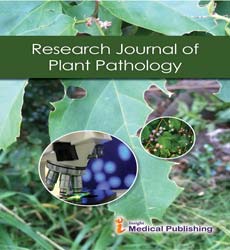The Hereditary Variety of Plant Reproducers
Tommy Lane*
Department of Plant Biotechnology, University of Derby, England, United Kingdom
- *Corresponding Author:
- Tommy Lane
Department of Plant Biotechnology,
University of Derby,
England,
United Kingdom,
E-mail: tom.lane76@swansea.ac.uk
Received Date: July 02, 2021; Accepted Date: July 16, 2021;Published Date: July 23, 2021
Citation: Lane T (2021) The Hereditary Variety of Plant Reproducers. J Plant Pathol Vol.4 No.3:e001.
Editorial Note
Plant reproducing is the study of changing the attributes of plants to create wanted characteristics. It has been utilized to work on the nature of sustenance in items for people and animals. The objectives of plant rearing are to deliver crop assortments that gloat exceptional and unrivalled qualities for an assortment of agrarian applications. The most habitually addressed attributes are those identified with biotic and abiotic stress resistance, grain or biomass yield, end-utilize quality qualities like taste or the groupings of explicit organic atoms (proteins, sugars, lipids, nutrients, strands) and simplicity of preparing (gathering, processing, heating, malting, mixing, etc.). Plant rearing can be cultivated through various procedures going from essentially choosing plants with positive attributes for proliferation, to strategies that utilize information on hereditary qualities and chromosomes, to more perplexing sub-atomic methods (see cultigen and cultivar). Qualities in a plant are what figure out what kind of subjective or quantitative characteristics it will have. Plant reproducers endeavour to make a particular result of plants and conceivably new plant varieties, and over the span of doing as such, slender down the hereditary variety of that assortment to a particular few biotypes. It is polished worldwide by people like landscapers and ranchers, and by proficient plant reproducers utilized by associations like government establishments, colleges, crop-explicit industry affiliations or exploration focuses. Global improvement organizations accept that rearing new harvests is significant for guaranteeing food security by growing new assortments that are higher yielding, infection safe, dry season open minded or territorially adjusted to various conditions and developing conditions.
One significant method of plant reproducing is choice, the interaction of specifically spreading plants with positive qualities and disposing of or "separating" those with less alluring characteristics. Another procedure is the conscious interbreeding (crossing) of intently or indirectly related people to create new yield assortments or lines with advantageous properties. Plants are crossbred to present attributes/qualities from one assortment or line into another hereditary foundation. For instance, a mold safe pea might be crossed with a highyielding yet powerless pea, the objective of the cross being to present build up obstruction without losing the high return qualities. Offspring from the cross would then be crossed with the high-yielding guardian to guarantee that the descendants were most similar to the high-yielding guardian, (backcrossing). The offspring from that cross would then be tried for yield (determination, as portrayed above) and mold opposition and high-yielding safe plants would be additionally evolved. Plants may likewise be crossed with themselves to create ingrained assortments for rearing. Pollinators might be rejected using fertilization sacks. Old style rearing depends generally on homologous recombination between chromosomes to create hereditary variety. The traditional plant raiser may likewise utilize various in vitro strategies like protoplast combination, incipient organism salvage or mutagenesis (see underneath) to create variety and produce cross breed plants that would not exist in nature.
Attributes that reproducers have attempted to fuse into crop plants include:
Worked on quality, like expanded nourishment, further developed flavour, or more noteworthy magnificence
• Expanded yield of the harvest
• Expanded resistance of ecological pressing factors (saltiness, outrageous temperature, and dry season)
• Protection from infections, parasites and microorganisms
• Expanded resilience to creepy crawly bothers
• Expanded resistance of herbicides
• Longer stockpiling period for the gathered harvest
Open Access Journals
- Aquaculture & Veterinary Science
- Chemistry & Chemical Sciences
- Clinical Sciences
- Engineering
- General Science
- Genetics & Molecular Biology
- Health Care & Nursing
- Immunology & Microbiology
- Materials Science
- Mathematics & Physics
- Medical Sciences
- Neurology & Psychiatry
- Oncology & Cancer Science
- Pharmaceutical Sciences
